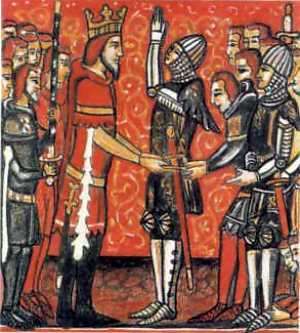Feudalism
Feudalism was a set of political and military customs in medieval Europe that flourished between the ninth and fifteenth centuries, which, broadly defined, was a system for ordering society around relationships derived from the holding of land in exchange for service or labor. Although derived from the Latin word feodum (fief), then in use, the term feudalism and the system it describes were not conceived of as a formal political system by the people living in the Medieval Period. In its classic definition, by François-Louis Ganshof (1944), feudalism describes a set of reciprocal legal and military obligations among the warrior nobility, revolving around the three key concepts of lords, vassals, and fiefs. There is also a broader definition, as described by Marc Bloch (1939), that includes not only warrior nobility but the peasantry bonds of manorialism, sometimes referred to as a "feudal society". Since 1974 with the publication of Elizabeth A. R. Brown's The Tyranny of a Construct, and Susan Reynolds' Fiefs and Vassals (1994), there has been ongoing inconclusive discussion among medieval historians if Feudalism is a useful construct for understanding medieval society
Definition
There is no broadly accepted modern definition of feudalism. The terms feudalism or feudal system were coined in the early modern period (17th century), and were often used in a political and propaganda context. By the mid-20th century, François Louis Ganshof's Feudalism, 3rd ed. (1964; originally published in French, 1947), became a traditional definition of feudalism. Since at least the 1960s, concurrent with when Marc Bloch's Feudal Society (1939) was first translated into English in 1961, many medieval historians have included a broader social aspect, adding the peasantry bonds of manorialism, sometimes referred to as a "feudal society". Since the 1970s, when Elizabeth A. R. Brown published The Tyranny of a Construct (1974), many have re-examined the evidence and concluded that feudalism is an unworkable term and should be removed entirely from the scholarly and educational discussion, or at least used only with severe qualification and warning.
Outside a European context, the concept of feudalism is normally used only by analogy (called semi-feudal), most often in discussions of Japan under the shoguns, and sometimes medieval and Gondarine Ethiopia. However, some have taken the feudalism analogy further, seeing it in places as diverse as ancient Egypt, the Parthian empire, the Indian subcontinent, and the antebellum American South.
The term feudalism has also been applied-often inappropriately or pejoratively - to non-Western societies where institutions and attitudes similar to those of medieval Europe are perceived to prevail. Some historians and political theorists believe that the many ways the term feudalism has been used has deprived it of specific meaning, leading them to reject it as a useful concept for understanding society
Classic feudalism
The classic François-Louis Ganshof version of feudalism describes a set of reciprocal legal and military obligations among the warrior nobility, revolving around the three key concepts of lords, vassals and fiefs. A lord was in broad terms a noble who held land, a vassal was a person who was granted possession of the land by the lord, and the land was known as a fief. In exchange for the use of the fief and the protection of the lord, the vassal would provide some sort of service to the lord. There were many varieties of feudal land tenure, consisting of military and non-military service. The obligations and corresponding rights between lord and vassal concerning the fief form the basis of the feudal relationship
Vassalage
Before a lord could grant land (a fief) to someone, he had to make that person a vassal. This was done at a formal and symbolic ceremony called a commendation ceremony composed of the two-part act of homage and oath of fealty. During homage, the lord and vassal entered a contract in which the vassal promised to fight for the lord at his command, whilst the lord agreed to protect the vassal from external forces. Fealty comes from the Latin 'fidelitas' and denotes the fidelity owed by a vassal to his feudal lord. "Fealty" also refers to an oath that more explicitly reinforces the commitments of the vassal made during homage. Such an oath follows homage.
Once the commendation ceremony was complete, the lord and vassal were now in a feudal relationship with agreed-upon mutual obligations to one another. The vassal's principal obligation to the lord was to "aid", or military service. Using whatever equipment the vassal could obtain by virtue of the revenues from the fief, the vassal was responsible to answer to calls to military service on behalf of the lord. This security of military help was the primary reason the lord entered into the feudal relationship. In addition, the vassal could have other obligations to his lord, such as attendance at his court, whether manorial, baronial or at the king's court itself. It could also involve the vassal providing "counsel", so that if the lord faced a major decision he would summon all his vassals and hold a council. On the manorial level this might be a fairly mundane matter of agricultural policy, but also included the handing down by the lord of sentences for criminal offenses, including capital punishment in some cases. Concerning the king's feudal court, such deliberation could include the question of declaring war. These are examples, depending on the period of time and location in Europe, feudal customs and practices varied, see examples of feudalism.
- More information is available at [ Wikipedia:Feudalism ]
Chat rooms • What links here • Copyright info • Contact information • Category:Root
